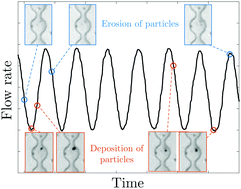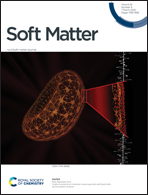Clog mitigation in a microfluidic array via pulsatile flows†
Abstract
Clogging is a common obstacle encountered during the transport of suspensions and represents a significant energy and material cost across applications, including water purification, irrigation, biopharmaceutical processing, and aquifer recharge. Pulsatile pressure-driven flows can help mitigate clogging when compared to steady flows. Here, we study experimentally the influence of the amplitude of pulsation 0.25P0 ≤ δP ≤ 1.25P0, where P0 is the mean pressure, and of the frequency of pulsation 10−3 Hz ≤ f ≤ 10−1 Hz on clog mitigation in a microfluidic array of parallel channels using a dilute suspension of colloidal particles. The array geometry is representative of a classical filter, with parallel pores that clog over time, yielding a filter cake that continues to grow and can interact with other pores. We combine flow rate measurements with direct visualizations at the pore scale to correlate the observed clogging dynamics with the changes in flow rate. We observe that all pulsatile amplitudes at 0.1 Hz yield increased throughput compared to steady flows. The rearrangement of particles when subject to a dynamic shear environment can delay the clogging of a pore or even remove an existing clog. However, this benefit is drastically reduced at 10−2 Hz and disappears at 10−3 Hz as the pulsatile timescale becomes too large compared to the timescale associated with the clogging and the growth of the filter cakes in this system. The present study demonstrates that pulsatile flows are a promising method to delay clogging at both the pore and system scale.



 Please wait while we load your content...
Please wait while we load your content...